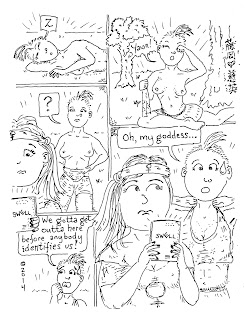The idea is basically to create an allegorical society (of merpeople, with castes and a certain sexual biology) and then deconstruct the memetic state transition rules that drop out of that configuration. Afterwards, use that elaboration as a mirror to examine human society, gender roles, economy, classism, and racism.
It will be a graphical, narrative, novelized, and philosophical adventure!
I have one or two more to do with the make-up habits of the high- and low-caste mermaids. Mermaids naturally glow when receptive, and high-caste mermaids use make-up to cover this (and besides, they live in the highly-lighted layers of the ocean, so this is not readily seen during the day), while low-caste mermaids tend to use make-up derived from glowing fish and other sea creatures to make them appear receptive all the time, or exaggeratedly so (glow around the eyes, etc.).
Ice-blue pearl (earrings) are one focus of the story. Teburah Seste-Lagalle, a high-caste mermaid, catches the heroine, Alluviel, out of her depth, so to speak, in the upper depths, when she got caught in a storm and could not return to the lower depths after gathering taboo seaweed, and makes her surrender her blue pearl earrings to avoid punishment (shearing of hair, yanking out of a tail scale).
The mermaid sexual cycle. A mermaid produces many eggs, on a cycle which may be driven by things like food, or just time, and then she either has intercourse with a merman, fertilizes them and actually gives birth, "caches" them in hopes a merman fertilize them (though as often as not a rival mermaid will smash them), or she (painfully) remetabolizes them. Caching the eggs requires some exposure to male musk, which typically happens when mermen fight sea monsters or each other. Hence, in the low castes, contests are often organized, and the mermen often just fight each other. In the upper castes, mermaids jealously cling to their mates. Some sneak off to taboo viewings of the low-caste merman contests, however, when they become full of eggs.



























































